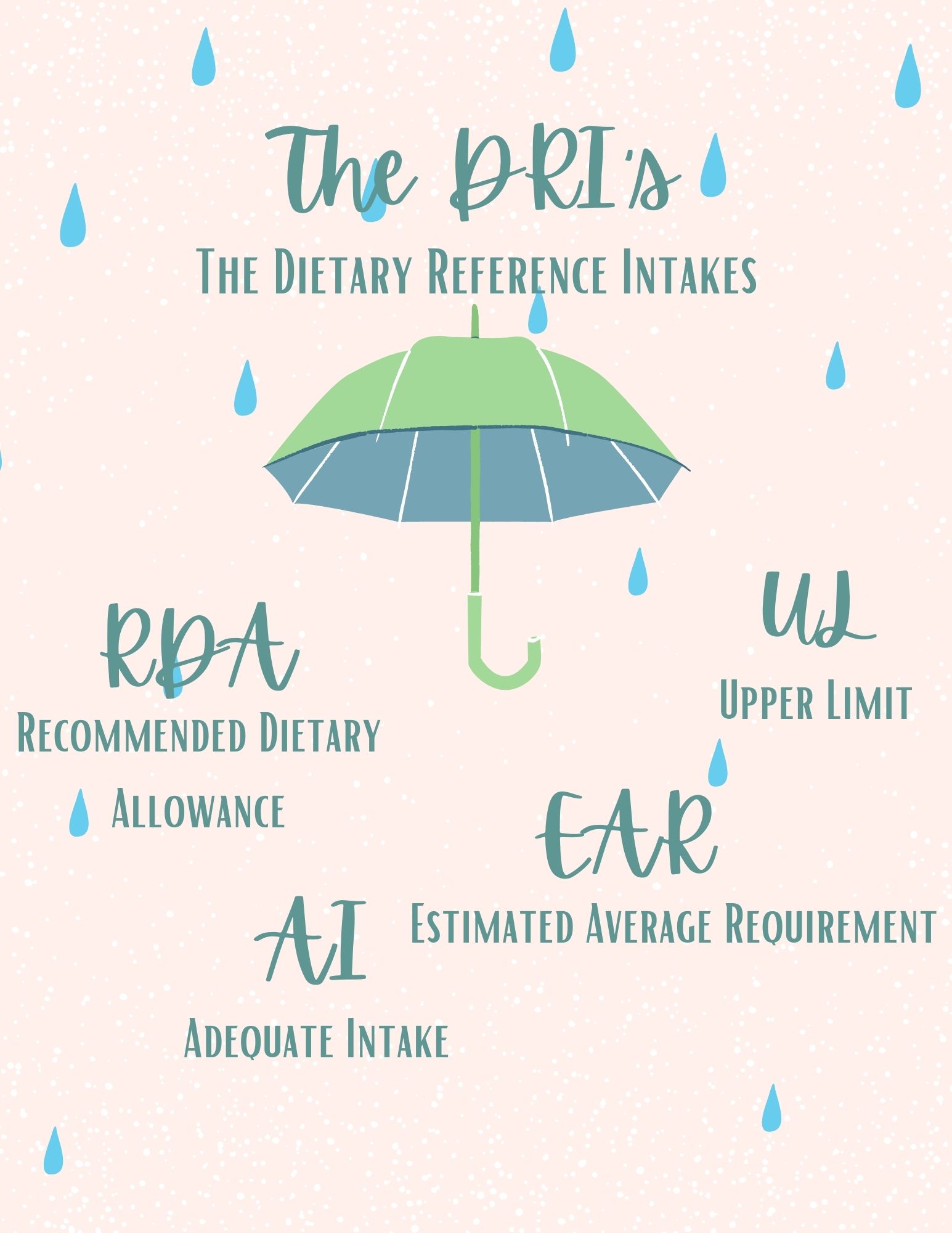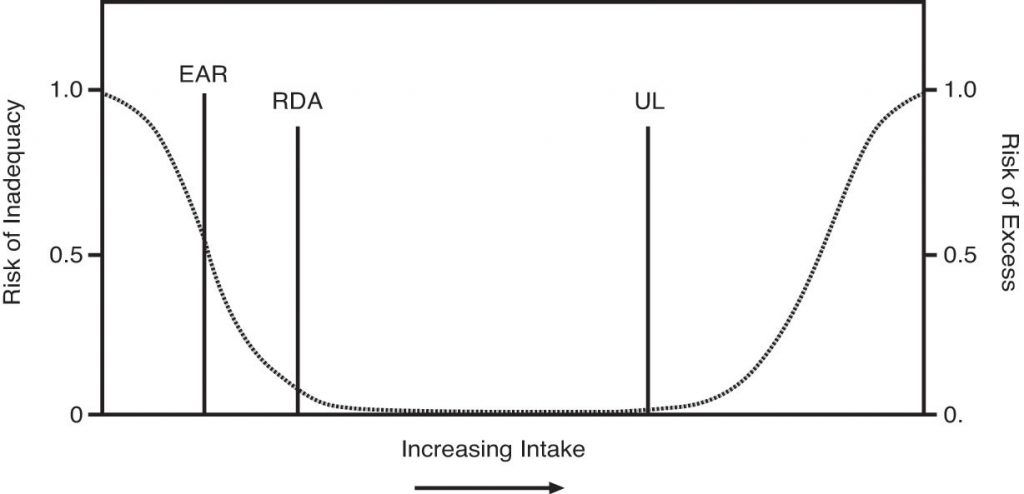2.1 Dietary Reference Intakes (DRIs)
The Dietary Reference Intakes (DRIs) are reference values for nutrients that help with nutrition planning and assessment of healthy individuals. DRIs were developed to address three aspects of nutrient intake: 1) the amount to prevent deficiency, 2) the amount that may reduce the risk of a specific health problem or disease, and 3) the amount that may increase health risks due to toxicity from over supplementation. We can think of the DRIs as an umbrella term that encompasses different aspects of nutrient intake.
Figure 2.1 The DRI’s

There are four measures that together comprise the DRIs:
- Estimated Average Requirement (EAR): a nutrient intake value that is estimated to meet the requirement of half the healthy individuals in a population group, or the average amount that an individual in that population group must consume to meet their needs for that nutrient. Population groups are determined by age, biological sex, and whether females are pregnant or lactating. If only half of a population group is meeting their needs, this means that half of the population group is not meeting their needs and may be at risk for deficiency. This is why EARs are not used to make nutrient recommendations. EARs are used to establish a “mean” intake for that nutrient. If we assume that a population’s nutrition needs are standardly distributed, we can use this “mean” to calculate how much of a nutrient will meet the needs of most of the population group.
- Recommended Dietary Allowance (RDA): the average daily dietary intake level that is sufficient to meet the nutrient requirement of nearly all (97-98%) healthy individuals in a population group. Once an EAR has been determined, the RDA is established approximately two standard deviations above the EAR. This is the basic quantity of a nutrient recommended to prevent deficiency disease.
- Adequate Intake (AI): AIs are created for nutrients when there is insufficient consistent scientific evidence to set an EAR for the entire population. As with RDAs, AIs can be used as nutrient-intake goals for a given nutrient. For example, there has not been sufficient scientific research into the particular nutritional requirements for infants. Consequently, all of the DRI values for infants are AIs derived from nutrient values in human breast milk. For older babies and children, AI values are derived from human milk coupled with data on adults. The AI is meant for a healthy target group and is not meant to be sufficient for certain at-risk groups, such as premature infants.
- Tolerable Upper Intake Level (UL): The UL was established to help distinguish healthful and harmful nutrient intakes. Developed in part as a response to the growing usage of dietary supplements, ULs indicate the highest level of continuous intake of a particular nutrient that may be taken without causing health problems. When a nutrient does not have any known issue if taken in excessive doses, it is not assigned a UL. However, even when a nutrient does not have a UL it is not necessarily safe to consume in large amounts.
The DRI’s are often referred to by dietitians and public health researchers to plan nutritious diets or to evaluate nutrient adequacy for clients or population groups and identify nutrients of concern based on a typical eating pattern. They can also be used to evaluate the nutritional adequacy of your own diet. If your average intake, over a period of time, is less than the AI or less than 66% of the RDA then you may be at risk for deficiency. On the other hand, if your intake is consistently above the UL then you may be at risk for toxicity. As stated earlier, toxicity is unlikely in individuals who are not taking large doses of vitamin and mineral supplements. As you can see in Figure 2.2 below, if your intake of a specific nutrient is above the RDA and below the UL, you will not need to worry about deficiency or toxicity from that nutrient.
Figure 2.2 Safe Nutrient Ranges

You can find more information on the DRIs and look at the reports and tables here.
What the DRIs are not useful for is to be used as a meal planning tool for the general population that does not have a background in nutrition. If you follow the link above to look at a DRI table, you will see that the DRIs are simply a table with nutrients and the minimum or maximum amounts of that nutrient an individual in a specific age-sex group should consume for ideal health. The DRIs do not list dietary sources of nutrients so if a 19 year old woman wants to plan a healthy diet she can see from the DRI table that her vitamin C intake should be at least 75 mg of vitamin C per day. However, the DRIs don’t tell her what types of foods or how much of each food she should eat to meet those goals. As we progress through this chapter, the tools and guidelines will become more user friendly. We can think of the DRIs as the science that the other nutrition recommendations are based on.
Media Attributions
- The DRI’s © Natalie Fox is licensed under a CC BY (Attribution) license
- DRI graph © University of Hawaii is licensed under a CC BY (Attribution) license
